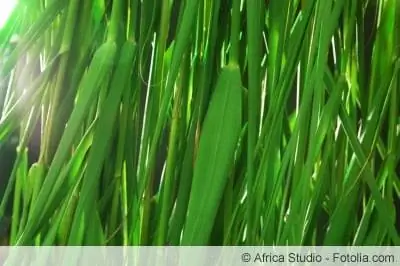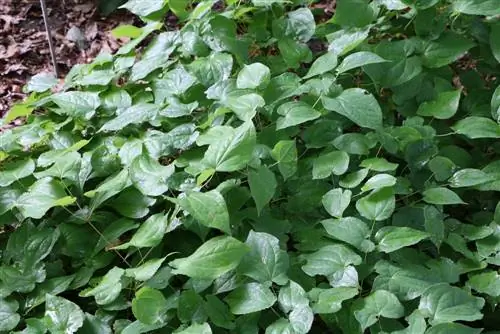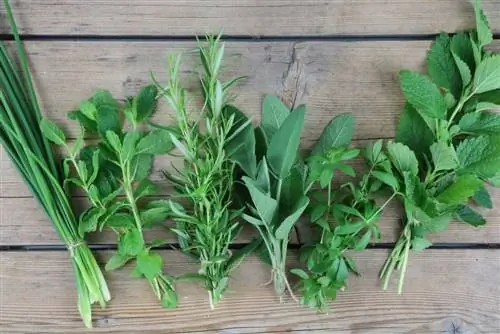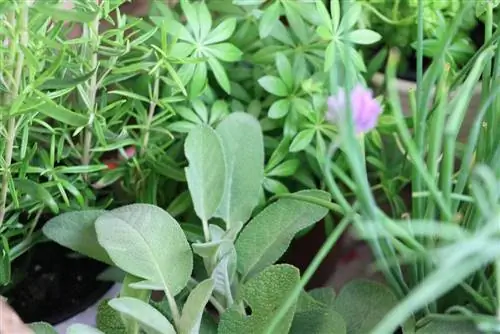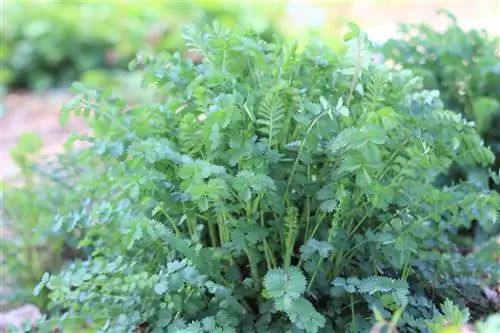- Author admin [email protected].
- Public 2023-12-17 03:39.
- Last modified 2025-01-24 12:45.
It covers 70 percent of the world's sugar needs and impresses with its magnificent appearance. The sugarcane plant combines utility and beauty in such an impressive way that cultivating it in an ornamental garden is a fascinating project. Although the following profile describes sugarcane as a tropical plant, it is certainly possible to grow it in your own garden as long as a few fundamental guidelines are followed. You can find out what these are and how to cultivate this exotic piece of jewelry here.
Profile
- Plant family of sweet grasses (Poaceae)
- Scientific name of the sugarcane plant: Saccharum officinarum
- Native to the tropics and subtropics
- Perennial and herbaceous in growth
- Temperature minimum: 3 to 5 degrees Celsius
- Growth height in cultivation from 150 to 300 cm
- Diameter of the stalks from 20 to 50 mm
- Panicle flowers 40 to 60 cm long in autumn
- Root system: underground shoot axes (rhizomes)
- Worldwide use for the production of household sugar
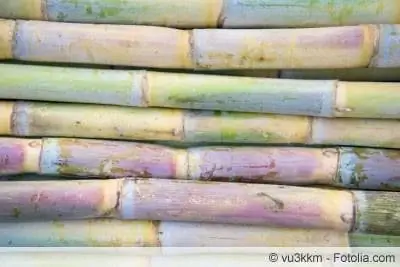
The plant residues from sugar cane after the harvest are further processed into animal feed, fuel and serve as a raw material for paper production. In addition, the sweet grass is increasingly being used to produce biofuel and electricity.
Growing from seeds
If you want to experience their growth from scratch, choose to grow them from seeds. Specialist retailers have high-quality seeds available all year round for a fee of less than 2 euros. If equipment is available that creates a tropically warm environment for the seeds, sowing takes place in the following steps:
- Fill a thermos flask with lukewarm water and soak the seeds in it overnight
- Fill pots with lean sowing soil, peat sand or standard soil and spray with water
- Place one seed in each seed container on the substrate to just press the light germinator on it
- Cover with cling film, place on a glass plate or put in the heated mini greenhouse
At a constant temperature of 22 to 25 degrees Celsius, the cotyledons break through the seed coat within 21 days. Any cover has then fulfilled its task and is removed so that the seedling does not hit it. During this time, the substrate must neither dry out nor become completely wet. The future sugar canes do not receive fertilizer in this phase.
Growing from cuttings
Growing sugar cane from cuttings is less complicated than sowing and has a higher success rate. To do this you need one or more ripe stalks that are cut into pieces with 2 to 4 eyes, also called nodes. To ensure that the plant grows vertically during cultivation, the cuttings must be positioned horizontally on the substrate. How to do it right:
- Fill pots with a volume of at least 5 liters with potting or pricking soil
- Place a cutting in each cultivation container in the substrate and cover it with soil to a maximum height of 15 cm
- Place in an indoor greenhouse that maintains a temperature level of 25 to 28 degrees
Ideally, water the sugarcane cuttings from below. To do this, fill a tub approx. 10 cm high with water that has as little lime as possible and place the pots in it. Due to capillary force, moisture is drawn into the substrate. If the surface feels damp, take the cultivation pots out of the water and put them in the warm mini greenhouse or heated winter garden. Under warm tropical conditions, vertical shoots sprout from the nodes within 2 to 4 weeks, while their own root system develops in the substrate.
Growing in the garden
Since the sugarcane plant is a tropical plant, cultivation in a bucket is the primary option in the Central European climate. If temperatures fall below 5 degrees Celsius, the plant dies. Grown in a bucket, the impressive ornamental grass spends the summer on the balcony, terrace or on the seating area so that it can be put away in time for winter. The planting season begins in mid to late May.
- Place the root balls of the early sugar cane plants in low-lime water
- Meanwhile, fill a large bucket with a volume of 20-40 liters with potting soil or garden soil-compost mixture
- Enrich the substrate with sand, polystyrene flakes or lava granules to improve permeability
- Previously create a drainage above the floor opening made of pebbles, grit or pottery shards
- Unpot the water-soaked young plant and plant it in the new pot at the same depth as before
- Leave a 5 centimeter pouring edge and pour generously

Place the pot in a sunny to partially shaded, warm and protected location in the garden. Within a few weeks the sugar cane has reached its final size. After 4 months the stalks are ripe for a first harvest.
Tip:
Plant sugar cane in a large pot with handles and sink it into the soil at a suitable location in the garden. In the fall, simply take the pot out of the ground again to put the plant away.
Care
Proper care for sugarcane depends on a balanced water and nutrient balance. Water the plant regularly with collected rainwater or decalcified tap water. The sunnier the location, the higher the degree of evaporation due to the powerful biomass. Therefore, check the moisture requirement daily using a thumb test. From June to September, apply an organic liquid fertilizer weekly. Alternatively, guano sticks or organic fertilizer cones are used to provide nutrients, especially if the stalks are grown to produce sugar for consumption. If the sugarcane plant is used solely for ornamental purposes, long-term mineral fertilizer can also be considered, for established specimens in March, May and July.
Harvesting and cutting
As summer comes to an end, the stalks are ready for harvest about 4 months after planting. Before clearing away, cut off individual stalks or the entire plant close to the ground. On average, you get 1 glass of sugar cane juice from 1 meter of stalk length. This juice is already suitable for consumption. Alternatively, the molasses is filtered and heated until the sugar crystals remain. Unless a harvest is intended, the stalks remain on the plant throughout the winter.
Tip:
If a sugarcane plant is getting old, use a he althy stalk to take cuttings. In this way you can propagate the tropical grass in time before it loses its beauty.
Wintering
If the temperatures fall permanently below 10 degrees Celsius, the time has come to move from the garden to the winter quarters. To do this, choose a bright room that ensures a constant heat of at least 15 degrees Celsius. In a cooler environment, the stalks die if they have not been harvested. In early spring, all withered parts of the plant are cut out to make room for the young shoots. Care during the cold season is limited to the following measures:
- Keep the substrate slightly moist, adapted to the reduced water requirement
- Do not apply fertilizer from October to February
- To prevent spider mites, spray the sugar cane from time to time with lime-free water

Repotting
The pronounced growth of sugar cane requires it to be moved to a larger container every year. The best time for this care measure is early spring. Repotting should be started at the latest when the rhizomes push up through the substrate or grow out of the opening in the ground. This is how it works:
- The new bucket is at least 10 centimeters larger in diameter
- Spread a drainage system made of inorganic, coarse materials over the water drain
- A mix of potted plant soil, expanded clay and sand is recommended as a substrate
First fill the new pot halfway with fresh potting soil and press a hollow into it with your fist. The sugar cane plant is then unpotted, planted in the middle and watered. It is important to note that the sweet grass should not be inserted deeper than before so as not to cause rot. Repotted into pre-fertilized soil, sugarcane receives the first fertilizer ration after 6 weeks at the earliest.
Conclusion
The cultivation of sugar cane is by no means limited to tropical regions. Taking into account the special requirements for adequate light and temperature conditions, the exotic sweet grass also thrives in the Central European climate. It is important to observe a minimum temperature of 5 degrees and to provide a bright, warm winter quarters. Then there's nothing wrong with cultivating this impressive plant in the garden.

